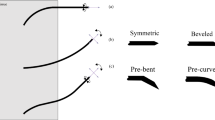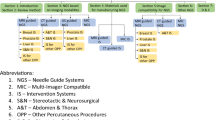Abstract
Objective
The objective of this study was to evaluate two features of a new rotating needle driver in a domestic swine model: (1) a quick release safety mechanism and (2) the impact of spinning the needle on the force profile.
Materials and methods
The experiments were conducted in a multi-modality interventional suite. An initial CT scan was obtained to determine the location of the target, in the liver or lung. The robotic arm was positioned directly over the marked skin entry point. Control parameters were set to rotation speeds of 0, 90, or 180 rpm. The breakaway force magnitude was also preset to a predetermined force. The physician used the joystick to drive the needle towards the target while the system recorded needle insertion depth and forces.
Results
Sixteen insertions were completed (14 in liver and 2 in lung) and 12 released the needle upon the desired set force. The mean response time of the quick release mechanism was 202 ± 39 ms. Needle rotation resulted in reduced insertion force.
Conclusion
The robot-assisted needle insertion system was shown to be functional in a multimodality imaging clinical environment on a swine model. The system has potential future applications in precision minimally invasive procedures including biopsy and radiofrequency ablation.
Similar content being viewed by others
References
Strasberg SM, Linehan D (2003) Radiofrequency ablation of liver tumors. Curr Probl Surg 40(8): 459–498
Wood BJ, Locklin JK, Viswanathan A, Kruecker J, Haemmerich D, Cebral J, Sofer A, Cheng R, McCreedy E, Cleary K, McAuliffe MJ, Glossop N, Yanof J (2007) Technologies for guidance of radiofrequency ablation in the multimodality interventional suite of the future. J Vasc Interv Radiol 18: 9–24
Wood BJ, Banovac F, Friedman M, Varro Z, Cleary K, Yanof J et al (2003) CT-integrated programmable robot for image-guided procedures: comparison of free-hand and robot-assisted techniques. J Vasc Interv Radiol 14: S62
Solomon SB, Patriciu A, Stoianovici DS (2006) Tumor ablation treatment planning coupled to robotic implementation: a feasibility study. J Vasc Interv Radiol 17(5): 903–907
Fichtinger G, Fiene J, Kennedy CW, Kronreif G, Iordachita I, Song DY, Burdette EC, Kazanzides P (2007) Robotic assistance for ultrasound guided prostate brachytherapy. Med Image Comput Comput Assist Interv 10(1): 119–127
Stenzel R, Lin R, Cheng P, Kronreif G, Kornfeld M, Lindisch D, Wood BJ, Viswanathan A, Cleary K (2007) Precision instrument placement using a 4-dof robot with integrated fiducials for minimally invasive interventions. In: Cleary KR, Miga MI (Eds) Proceedings of SPIE. vol. 6509, no. 1. SPIE, 2007, p 65092S. http://link.aip.org/link/?PSI/6509/65092S/1
Kettenbach J, Kronreif G, Figl M, Fürst M, Birkfellner W, Hanel R, Ptacek W, Bergmann H (2005) Robot-assisted biopsy using computed tomography-guidance initial results from in vitro tests. Invest Radiol 40(4): 219–228
Jantschke R, Haas T, Madoerin P, Dziergwa S (2007) Preparation, assistance and imaging protocols for robotically assisted mr and ct-based procedures. Minim Invasive Ther Allied Technol 16(4): 217–221
Hevezi J, Blough M, Hoffmeyer D, Yanof JH (2002) Brachytherapy using CT PinPoint. MEDICAMUNDI 46(3): 22–27
Hata N, Hashimoto R, Tokuda J, Morikawa S (2005) Needle guiding robot for mr-guided microwave thermotherapy of liver tumor using motorized remote-center-of-motion constraint. In: IEEE International Conference on Robotics and Automation, pp 1652–1656
Cleary K, Melzer A, Watson V, Kronreif G, Stoianovici D (2006) Interventional robotic systems: applications and technology state-ofthe-art. Minim Invasive Ther Allied Technol 15(2): 101–113
Taylor RH (2006) A perspective on medical robotics. Proc IEEE 94(9): 1652–1664
Muller SA, Maier-Hein L, Mehrabi A, Pianka F, Rietdorf U, Wolf I, Grenacher L, Richter G, Gutt CN, Schmidt J, Meinzer HP, Schmied BM (2007) Creation and establishment of a respiratory liver motion simulator for liver interventions. Med Phys 34(12): 4605–4608
Riviere C, Thakral A, Iordachita II, Mitroi G, Stoianovici D (2001) Predicting respiratory motion for active canceling during percutaneous needle insertion. In: Proc 23rd Annual Intl Conf IEEE Engineering in Medicine and Biology Society, October, pp 3477–3480
Badano F, Danel F (1995) The NEURO-SKILL robot: a new approach for surgical robot development. In: MRCAS, pp 318–323
Kazanzides P, Mittelstadt BD, Musits BL, Bargar WL, Zuhars JF, Williamson B, Cain PW, Carbone EJ (1995) An integrated system for cementless hip replacement. IEEE Eng Med Biol Mag 14(3): 307–313
Abolhassani N, Patel RV, Ayazi F (2007) Minimization of needle deflection in robot-assisted percutaneous therapy. Int J Med Robot 3(2): 140–148
Okamura AM, Simone C, O’Leary MD (2004) Force modeling for needle insertion into soft tissue. IEEE Trans Biomed Eng 51(10): 1707–1716
Nath S, Chen Z, Yue N, Trumpore S, Peschel R (2000) Dosimetric effects of needle divergence in prostate seed implant using 125I and 103Pd radioactive seeds. Med Phys 27(5): 1058–1066
DiMaio SP, Salcudean SE (2005) Needle steering and motion planning in soft tissues. IEEE Trans Biomed Eng 52(6): 965–974
Abolhassani N, Patel R, Moallem M (2004) Experimental study of robotic needle insertion in soft tissue. Int Congr Ser CARS—Comput Assist Radiol Surg 1268: 797–802
Wei Z, Ding M, Downey D, Fenster A (2005) 3D TRUS guided robot assisted prostate brachytherapy. Med Image Comput Comput Assist Interv 8(2): 17–24
Stoianovici D, Cleary K, Patriciu A, Mazilu D, Stanimir A, Craciunoiu N, Watson V, Kavoussi L (2003) Acubot: a robot for radiological interventions. IEEE Trans Robot Autom 19(5): 927–930
Cleary K, Watson V, Lindisch D, Taylor RH, Fichtinger G, Xu S, WC S, Donlon J, Taylor M, Patriciu A, Mazilu D, Stoianovici D (2005) Precision placement of instruments for minimally invasive procedures using a “Needle Driver” robot”. Int J Med Robot 1(2): 40–47
Neuenfeldt EM (2003) Method and device to reduce needle insertion force. U.S. Patent Number 6626848, Tech Rep
Author information
Authors and Affiliations
Corresponding author
Additional information
The mention of commercial products, their source, or their use in connection with material reported herein is not to be construed as either an actual or implied endorsement of such products by the U.S. Food and Drug Administration, the Department of Health and Human Services or the Public Health Service.
Rights and permissions
About this article
Cite this article
Shah, S., Kapoor, A., Ding, J. et al. Robotically assisted needle driver: evaluation of safety release, force profiles, and needle spin in a swine abdominal model. Int J CARS 3, 173–179 (2008). https://doi.org/10.1007/s11548-008-0164-2
Received:
Accepted:
Published:
Issue Date:
DOI: https://doi.org/10.1007/s11548-008-0164-2




